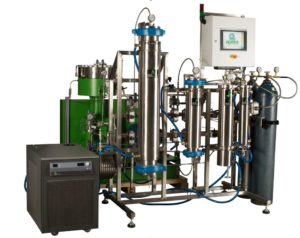On 4/6 I had the pleasure of speaking at Women Grow Philly at Benjamin’s Desk in Center City. What a great space! It was certainly one of the more vibrant places I’ve spoken!
With a group of about 50 people, I discussed a topic that I’ve spoken about before, but with a different perspective. When speaking about plant production, usually I’m giving a well rounded, 360 view of the process from building set up to harvest. This time, since PA is really focusing on extraction, I geared 80% of the presentation on the processing that takes place after harvest.
There is a lot of interest surrounding the specifics of the extraction process and the methods that processors have to choose between, like CO2 vs hydrocarbon, so we talked about a few of the pros and cons that could make one better than the other for your specific operation. I always reiterate that it’s not realistic to give a blanket response about one being better than the other, and the decision of which method of employ will depend on a few things. Here are the top 3:
- What products are you planning to produce for sale? Hydrocarbon is better for waxes and shatters whereas CO2 is better for vape cartridges (just to scratch the surface).
- What are your production demands? The amount of material you intend to process and the set up of your production line will steer you one way or the other.
- What does your P&L need to say? Capital investment and production capacity can vary wildly depending on your setup, so the company’s vision, mission, and operation must all align.
An Apeks Supercritical CO2 Extractor

A Precision PX1 Closed-Loop Hydrocarbon Extractor

A few more takeaways:
- Both CO2 and Hydrocarbon (BHO) extraction can be safely done with the right equipment and the right professionals.
- CO2 is perceived as safer than hydrocarbon since CO2 doesn’t explode, though asphyxiation becomes a risk at high levels.
- Closed-loop hydrocarbon extractors like the PX1 by Precision (pictured) are the gold standard in the industry which prevent any solvent or hydrocarbon from being released into the room or atmosphere.
- Regulations are quickly evolving to force all extraction to be done within a Class 1 Division 1 room – a special classification as defined by the National Fire Protection Association (NFPA) Publication 70, National Electric Code® (NEC) in Articles 500 to 506 and subsequently adopted by OSHA. These rooms are explosion-proof and become wind tunnels at the flip of the switch or activation of a sensor to evacuate anything potentially hazardous.
If you’d like to get a visual of the concept of airflow evacuation of a class 1 division 1 room, you can view the demo below. It demonstrates a contaminant being released in the air (think butane) and then instantly being evacuated by the system within the room.
Thank you again to Women Grow and Stephanie Thomas – I look forward to the next time!
-Brian Staffa


